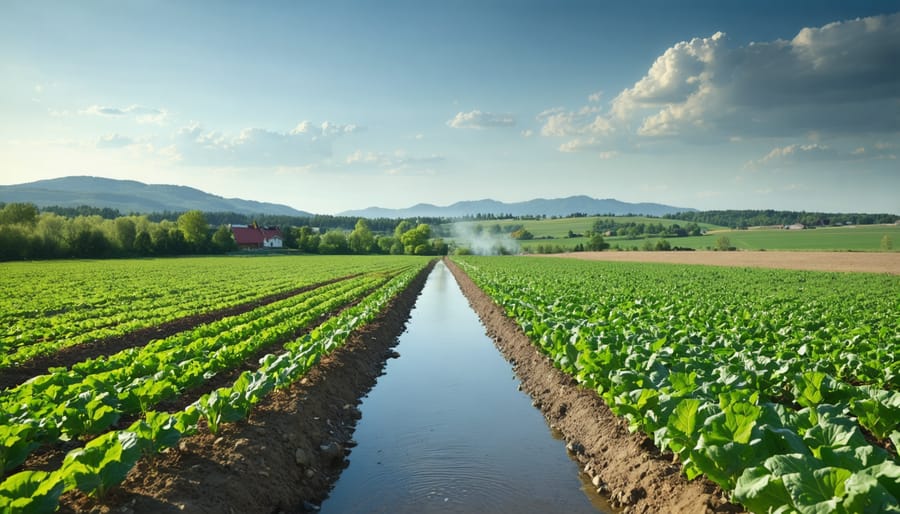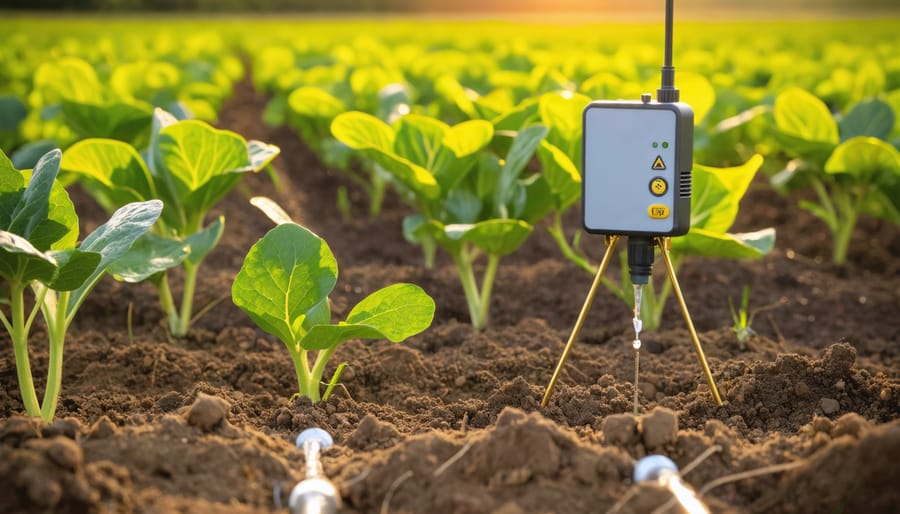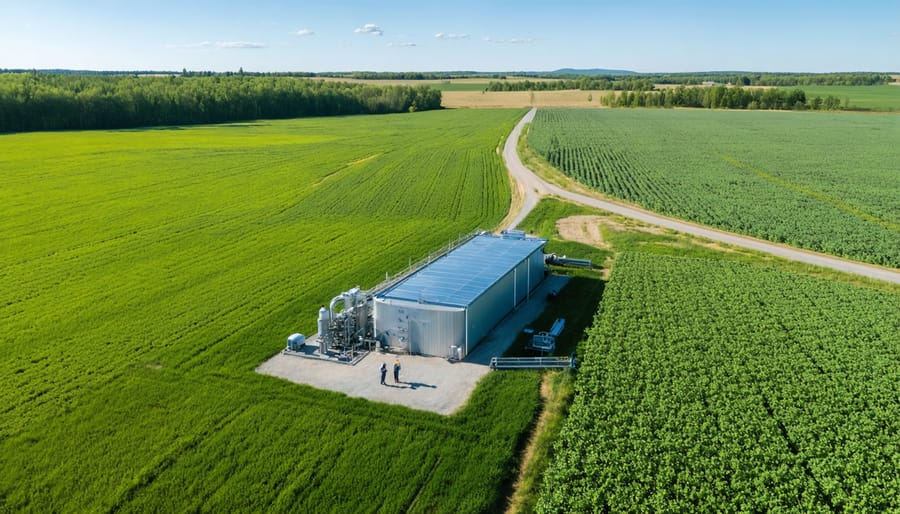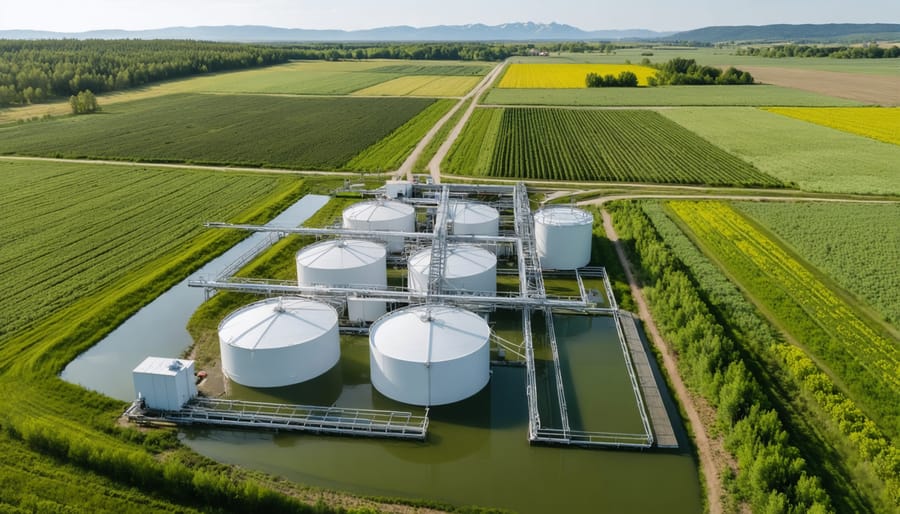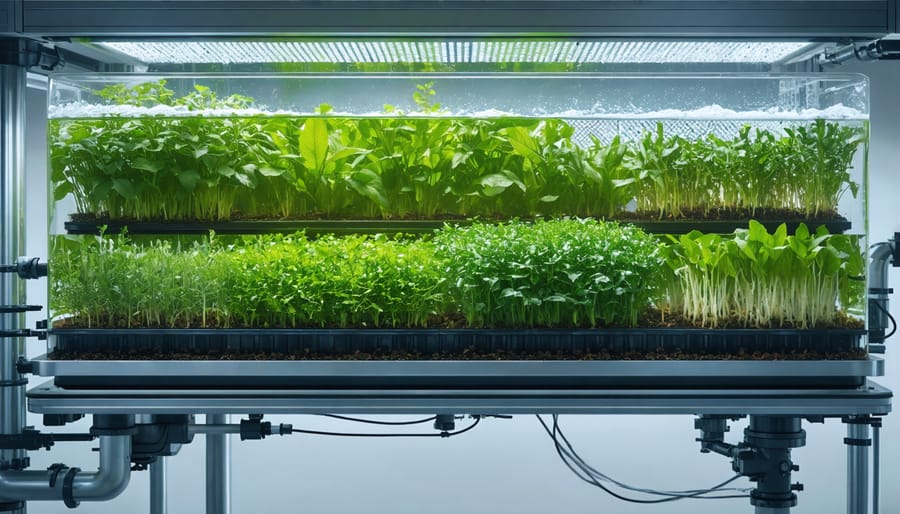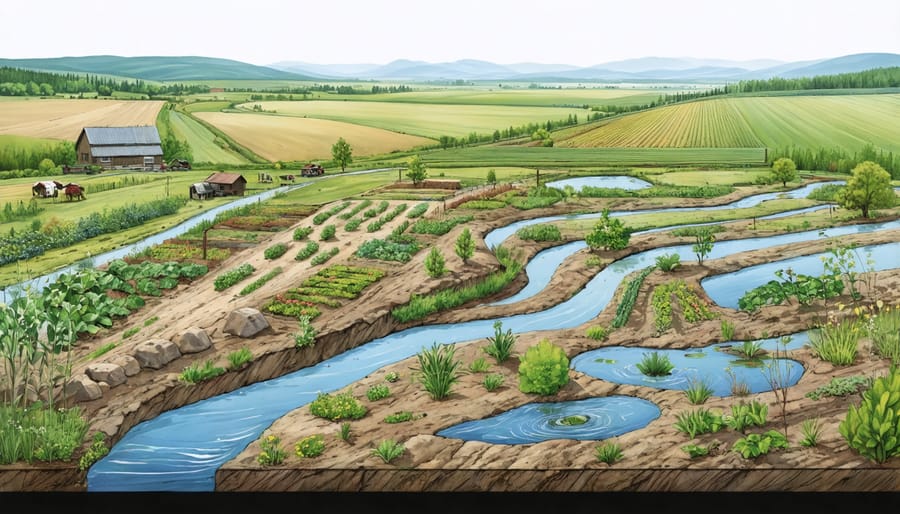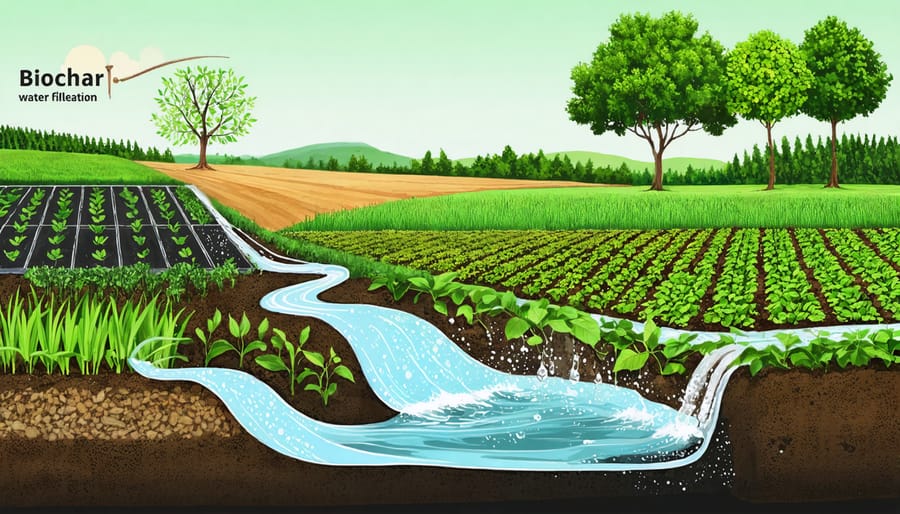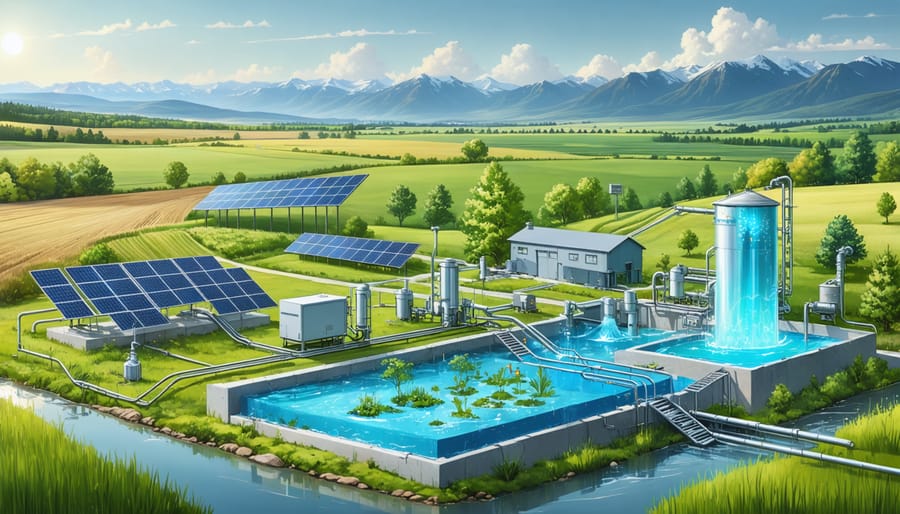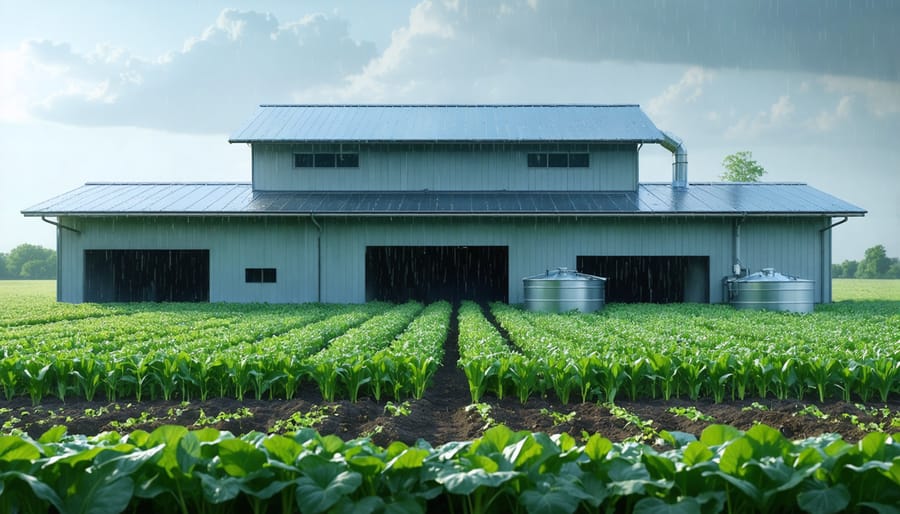Transform your farm’s water footprint by implementing a greywater reuse system – a practical solution that recycles household wastewater for agricultural irrigation while adhering to Alberta’s environmental regulations. This sustainable approach to water conservation strategies reduces freshwater consumption by up to 30% annually, offering significant cost savings during drought periods. Modern greywater systems, when properly designed for Alberta’s climate, effectively filter and redistribute water from sinks, showers, and laundry directly to crop irrigation systems, creating a closed-loop water cycle that benefits both farm operations and local watersheds. Recent case studies from Southern Alberta demonstrate that farms utilizing greywater systems maintain crop yields while reducing their reliance on municipal water sources by an average of 40,000 liters per growing season – a compelling reason to consider this proven water management solution for your agricultural operation.
Understanding Greywater in the Canadian Agricultural Context
What Qualifies as Greywater on Your Farm
On Canadian farms, greywater typically comes from household and farm building sources that haven’t been contaminated with human waste. This includes water from sinks, showers, washing machines, and dairy parlour cleanup operations. In Alberta, many farmers are finding creative ways to reuse water from these sources, particularly during dry seasons.
Kitchen sink water, while technically greywater, requires extra consideration due to food particles and grease content. Laundry water is generally suitable for reuse, though it’s important to use biodegradable detergents that won’t harm your soil or plants. Equipment washdown water can also be repurposed, provided you’re using environmentally friendly cleaning products.
Water from bathroom sinks and showers is particularly valuable for greywater systems, as it typically contains minimal contaminants. However, it’s crucial to note that any water containing human waste, including toilet water (blackwater), must never be included in your greywater system.
For dairy operations, parlour wash water can be suitable for reuse in certain applications, though it requires proper filtration to remove milk fats and cleaning chemical residues. Always check local regulations, as requirements for handling dairy facility water can vary across different regions of Alberta.
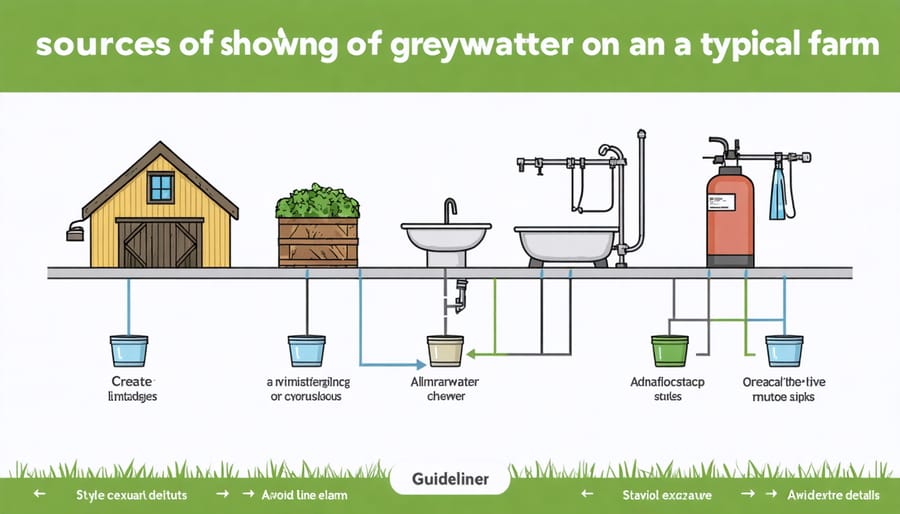
Alberta’s Regulations for Agricultural Greywater Use
In Alberta, greywater reuse for agricultural purposes is regulated under the Environmental Protection and Enhancement Act (EPEA) and the Water Act. Farmers looking to implement greywater systems must first obtain approval from Alberta Environment and Parks, particularly when the daily water usage exceeds 25 cubic metres.
The regulations specify that greywater must undergo appropriate treatment before agricultural use, with minimum requirements including filtration and disinfection. Storage systems must be properly sealed and labeled, with clear signage indicating non-potable water use throughout the distribution system.
Regular water quality testing is mandatory, with specific focus on biological contamination levels, pH, and suspended solids. Farmers must maintain detailed records of system maintenance, water quality tests, and usage volumes for annual reporting.
Local municipalities may have additional bylaws governing greywater use, so it’s essential to check with your county or municipal district. Alberta’s Agricultural Operation Practices Act (AOPA) also provides guidance on managing water resources in farming operations, including greywater applications.
For support in navigating these regulations, Alberta’s Ministry of Agriculture and Irrigation offers free consultations through their regional offices.
Building Your Farm’s Greywater System
Cold-Climate Design Considerations
Alberta’s harsh winters present unique challenges for greywater reuse systems, requiring specific adaptations to ensure year-round functionality. Like other cold climate irrigation solutions, these systems need robust insulation and strategic placement to prevent freezing.
Underground components should be installed below the frost line, typically 1.8 to 2.4 metres deep in Alberta. Insulated piping with heat tape or similar heating elements helps prevent freezing in exposed areas. Storage tanks require placement in heated spaces or underground with proper insulation, and incorporating air gaps can provide additional freeze protection.
For winter operation, consider a bypass system that diverts greywater directly to the septic system or municipal sewer during extreme cold snaps. This flexibility ensures system longevity and prevents damage from frozen pipes. Adding environmentally-friendly antifreeze solutions to key components can provide extra protection when temperatures plummet below -30°C.
Local farmers have found success using heat exchangers to maintain optimal temperatures in storage tanks, while others incorporate greenhouse applications that benefit from the residual heat in greywater. These adaptations not only protect the system but also maximize its efficiency year-round, making greywater reuse viable even in our challenging prairie climate.
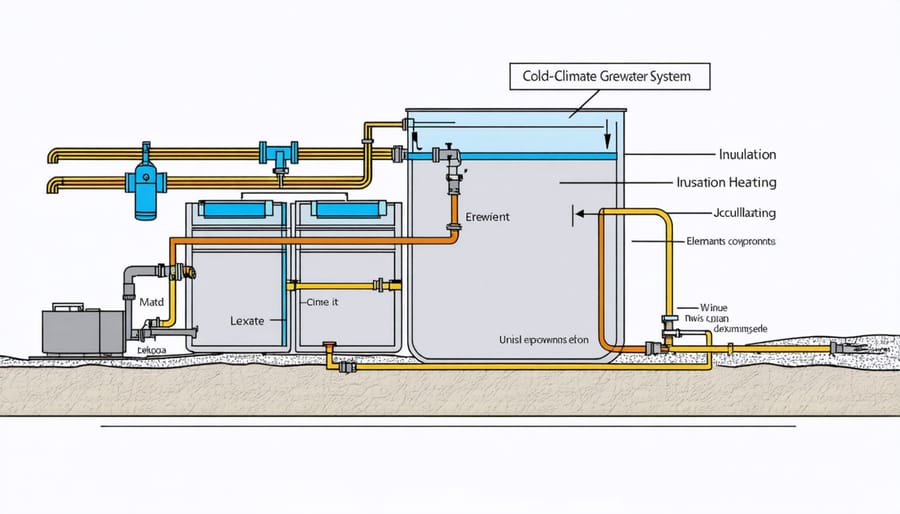
Essential Components and Setup
Setting up a greywater reuse system starts with careful planning and selection of essential components. The primary elements include a collection system, filtration unit, storage tank, and distribution network. For most Alberta farms, a 1,000-litre storage tank proves sufficient for managing household greywater from sinks, showers, and laundry.
Begin by installing collection pipes (minimum 5 cm diameter) that direct greywater from your home to the primary filter. These pipes should maintain a consistent slope of 2% to prevent water stagnation. The filtration system typically consists of a three-stage process: a coarse filter for larger particles, a fine filter for smaller debris, and a biological filter using natural media like gravel and sand.
Like many successful decentralized water treatment systems, your setup should include a diverter valve to redirect water to the septic system during maintenance or when using harsh cleaning products.
The storage tank should be UV-resistant and placed underground in our climate to prevent freezing. Install a pump (typically 0.5-1 HP) with automatic shut-off capabilities to distribute water to your irrigation system. For safety, include clear labeling on all components and ensure backflow prevention devices are installed where greywater lines might cross potable water systems.
Remember to position the entire system to allow gravity flow where possible, reducing energy requirements and maintenance needs. Regular inspection points should be accessible, especially in our winter conditions.
Maintenance and Monitoring
Regular maintenance of your greywater reuse system is crucial for long-term success and compliance with Alberta’s agricultural guidelines. Start by checking filters weekly during peak growing seasons and monthly during slower periods. Clean or replace filters as needed to prevent clogging and ensure proper water flow.
Monitor your storage tanks monthly for sediment buildup and clean them every six months. In our prairie climate, it’s especially important to inspect all outdoor components before winter to prevent freeze damage. Consider adding tank heaters if your system operates year-round.
Keep a maintenance log to track system performance and any issues that arise. Watch for signs of potential problems like unusual odours, reduced water flow, or changes in soil moisture levels. If you notice plant stress or soil discoloration, test your greywater quality immediately.
For troubleshooting common issues, start with the basics. If water flow decreases, check for blocked filters or pipes. Strange smells often indicate that the system needs cleaning or that retention times are too long. For more complex problems, consider joining local farming networks where experienced greywater system users can offer guidance.
Remember to conduct annual professional inspections to ensure your system meets local health and safety standards. Many Alberta farmers schedule these checks during spring preparation to catch any winter damage early.
Maximizing Greywater Benefits in Organic Production
Crop Selection and Irrigation Methods
When selecting crops for greywater irrigation, it’s essential to consider both plant characteristics and water quality. Root vegetables like potatoes and carrots should not be directly irrigated with greywater, but fruit trees, berry bushes, and ornamental plants typically thrive with this water source. In Alberta’s climate, drought-resistant perennials and native plants are particularly well-suited for greywater systems.
For optimal results, implement drip irrigation or subsurface distribution methods rather than sprinkler systems. This approach minimizes plant contact with greywater and reduces potential soil contamination. Many Alberta farmers have found success using mulch basins around trees and shrubs, which naturally filter the water while providing nutrients to plants.
When designing your irrigation system, maintain a 15-centimetre buffer between the soil surface and greywater distribution points. This gap helps prevent direct contact between edible portions of plants and greywater. For greenhouse operations, consider using greywater for non-food crops or ornamental species.
Local farmer Sarah Thompson from Lacombe shares, “We’ve successfully used greywater to irrigate our apple orchard for three years now. The key is maintaining consistent soil moisture levels and monitoring plant health regularly.”
Remember to rotate irrigation zones to prevent soil saturation and salt buildup. During Alberta’s winter months, direct greywater to indoor growing spaces or store it properly until spring. Always test soil pH levels quarterly and adjust your irrigation strategy based on seasonal changes and crop requirements.
For leafy greens and other fresh produce, use traditional irrigation methods with fresh water to ensure food safety compliance with provincial regulations. This balanced approach allows you to maximize water efficiency while maintaining crop quality and safety standards.
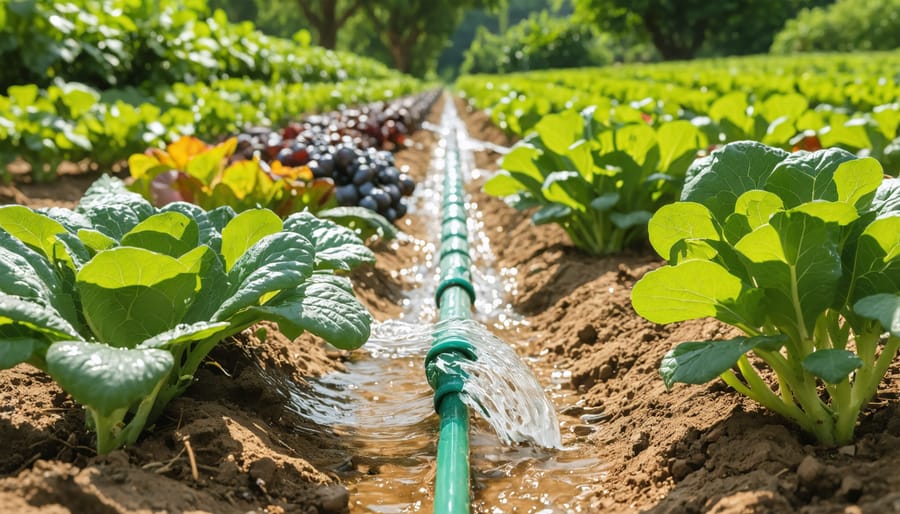
Soil Health and Nutrient Management
Implementing a greywater reuse system can significantly impact your soil’s health and biological activity. When properly managed, greywater irrigation can enhance soil moisture management while supporting beneficial microorganisms essential for organic farming.
Studies from Alberta’s Organic Research Centre show that greywater-irrigated soils typically maintain higher microbial activity compared to conventionally irrigated fields. However, it’s crucial to monitor sodium levels, as some household products can affect soil structure over time. Using biodegradable, phosphate-free soaps and detergents helps maintain compliance with organic certification standards while protecting soil health.
To ensure your greywater system aligns with organic certification requirements, maintain detailed records of water sources and any products that might enter the system. The Canadian Organic Standards specifically allow greywater use when properly treated and monitored. Regular soil testing is recommended every spring and fall to track nutrient levels and adjust your management practices accordingly.
Local farmer Sarah Thompson from Red Deer County shares, “Since implementing our greywater system three years ago, we’ve noticed improved soil structure and water retention. The key is choosing the right household products and rotating irrigation zones to prevent nutrient accumulation.”
For optimal results, incorporate cover crops and maintain adequate organic matter levels in your soil. This combination helps buffer potential pH changes and supports healthy nutrient cycling. Remember to conduct annual soil tests and adjust your greywater application rates based on crop needs and soil conditions. Many Alberta farmers successfully use greywater systems while maintaining their organic certification by following these guidelines.
Real Results: Alberta Success Stories
The Lethbridge County Thomson Family Farm stands as a shining example of successful greywater implementation in Alberta. Since installing their greywater reuse system in 2018, the Thomsons have reduced their freshwater consumption by 40%, saving approximately 250,000 litres annually. “The system paid for itself within two years through water savings alone,” explains Sarah Thomson, who uses the reclaimed water for irrigating their greenhouse crops and cleaning farm equipment.
In Red Deer County, the Martinez Organic Ventures showcases how greywater systems can thrive even in colder climates. Their innovative winter-proof design, implemented in 2019, collects water from their on-site processing facility and staff washrooms. The treated water irrigates their 2-hectare market garden, supporting year-round greenhouse operations. “We’ve cut our water bills by 35% while maintaining our organic certification,” reports owner Miguel Martinez.
The Prairie Rose Eco-Farm near Edmonton demonstrates the community impact of greywater adoption. This educational farm hosts workshops showing other farmers how their three-stage filtration system works. “We’ve helped five neighboring farms design similar systems,” says owner Rachel Chen. Their system processes 1,000 litres daily, supporting both crop irrigation and livestock facility cleaning.
Perhaps the most inspiring success story comes from the Brown family farm in Drumheller. Starting with a modest greywater collection system for their household in 2017, they’ve gradually expanded to include their dairy operation’s washing facilities. The Browns now save over 400,000 litres of water annually, while their soil quality has improved significantly due to the nutrient-rich irrigation water.
These success stories highlight the adaptability of greywater systems across different agricultural operations. Each farm modified standard designs to suit their specific needs, climate conditions, and regulatory requirements, proving that greywater reuse is both practical and profitable for Alberta farmers.
Implementing a greywater reuse system on your farm is a smart investment in both environmental stewardship and operational efficiency. By recycling household water for irrigation, you can reduce water costs by 30-50% while contributing to sustainable farming practices in Alberta. The benefits extend beyond water conservation to include reduced strain on septic systems and enhanced soil nutrition through naturally occurring nutrients in greywater.
To get started, connect with local agricultural extension offices for guidance on permits and regulations. Consider starting small with a simple kitchen-to-garden system before scaling up. Join the growing network of Alberta farmers already using greywater systems and share experiences through regional farming associations. With proper planning and maintenance, your greywater system can provide reliable irrigation while supporting sustainable water management for future generations of Canadian farmers.
Remember, every drop counts in building resilient agricultural practices for our changing climate.

